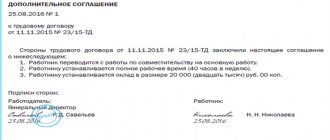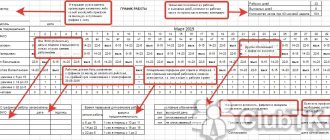Currently in Russia there are trends in increasing labor productivity and improving performance results. Employers are considering various options for daily routines, using an individual approach to employees, in particular, using the sliding work schedule possible under the Labor Code of the Russian Federation. Thus, in factories, some workers work continuously so that production does not stop, and many stores are open 12 hours for the convenience of customers.
What does flexible work schedule mean?
Working in flexible working hours means that the employee has the right to choose the start and end of his work, as well as the number of hours worked. It should be taken into account that the total number of hours is established in the organization’s staffing table. The agreement between employer and employee must be mutual.
The legislative framework
The above labor process is regulated by the Labor Code of the Russian Federation, in particular Art. 102, which specifies the features of regulating labor relations with a flexible schedule.
In addition, the Appendix to Order No. 112 of September 8, 2003 of the Ministry of the Russian Federation contains a list of professions in the field of communications and information where the introduction of flexible working hours is necessary.
In what documents is it fixed?
The employee’s working hours and accounting period are specified in the employment contract. The sample and form of the contract is standard. Familiarization and drawing up of an employment contract are usually carried out in the personnel department.
Shift work schedule: Labor Code (Labor Code of the Russian Federation)
Shift work schedule is regulated by Art. 103 of the Labor Code of the Russian Federation. According to this article, a shift work schedule (work in 2, 3 or 4 shifts) is established in institutions where the production process exceeds the permissible standard duration of daily work, as well as for the purpose of maximizing the efficient use of machinery and equipment, increasing the volume of products produced, goods (services provided) ).
The shift work schedule provides for the division of all workers into certain groups, each of which is obliged to work within the approved duration of working hours in accordance with the shift schedule.
Since the shift schedule is an annex (addition) to the collective agreement and directly affects the interests of employees, during its preparation the employer is obliged to take into account the position and opinion of the representative body of employees, which, as a rule, is a trade union organization. The procedure for reaching consensus between the employer and the representative body is established by Art. 372 Labor Code of the Russian Federation.
The employer is obliged to properly familiarize employees with the approved shift schedule no later than one month before the start of its introduction into the production process.
What are the types
A flexible work schedule according to the Labor Code of the Russian Federation provides for sliding, floating and shift modes.
Let's take a closer look at each of them:
- A floating work schedule is a system that involves a sequence of working days and days off. For example, two working days and two days off, or a working day after two non-working days. This schedule is found among sellers and security guards.
- Shift work is a regime with shifts from five to twelve hours. The employer offers the employee day and night shifts used in the organization. Thus, at manufacturing enterprises in the shops, workers work continuously, shifts begin in the morning, then during the day workers are replaced by others, in the evening, therefore, the next shift begins work.
- Sliding is a labor system that does not tie an employee to a specific schedule. He has the right to independently determine the hours of his activity, taking into account the completion of a certain volume of tasks.
The concept and features of a sliding work schedule at an enterprise
- for 1 day, during which the required time is worked out in one day;
- regimen equal to 1 week;
- a regime equal to one month, therefore, during this period of time the employee must work out the established norm.
The main difference is that with a shift schedule, people come to work regularly according to a predetermined shift, so there is a specific time when they must be at work. In a flexible mode, the time of arrival at work and end of the working day is determined in free form.
Rules of application
Establishing a flexible work schedule requires documentation and a special procedure for calculating hours worked.
Documentary support
If an employee chooses this mode, it is necessary to submit an application with a proposal to make changes to the hours of work, on the basis of which the order is formed. Next, an additional agreement is drawn up.
The employer, if he shows his initiative, draws up such a schedule in the manner established by Article 74 of the Labor Code of the Russian Federation.
Working time calculation
The employment contract must indicate the employee's working hours. The calculation is made either by an employee of the HR department or by direct management entrusted with this type of work.
The following points must be provided for in the organization:
- Fixed time is the hours that an employee is required to spend at his workplace.
- Variable time – hours that the employee can choose himself, i.e. start and end times of work.
- Lunch and rest breaks are non-working hours.
- Duration of the working period: day, week, month.
Weekend
Depending on the type of schedule (free, shift or floating), days off are also set. Free provides that the employee independently chooses the days of work and rest. But this is discussed with the employer. The main thing is that the scope of the task is completed.
If the company uses a shift schedule, then the days off will take into account the employee’s shifts. The main emphasis is on the number of hours worked per day; days off can be either a weekday or a weekend.
A floating schedule establishes working and non-working days with a certain variability. Maybe two after two, a week after a week, etc.
What about the holidays?
The Labor Code of the Russian Federation establishes that an employee, regardless of employment schedule, is entitled to appropriate wages on holidays. If an employee performs his duties on a holiday, he must be paid double, which is regulated by Art. 153 Labor Code of the Russian Federation.
Valid reasons for leaving work
Unfortunately, the Labor Code of the Russian Federation does not contain information regulating valid reasons for dismissing employees. Because of this, employees often encounter difficulties along the way, ranging from management’s refusal to remove them to non-payment of funds, including payment for unused vacations. In addition, enterprises, if an employee leaves, often require him to pay for the training or advanced training he has completed. Despite the huge number of pitfalls, the courts of the Russian Federation have made very different decisions on these issues.
However, according to Article 80 of the Labor Code of the Russian Federation:
“An employee has the right to terminate an employment contract by notifying the employer in writing no later than two weeks in advance, unless a different period is established by this Code or other federal law. The specified period begins the next day after the employer receives the employee’s resignation letter.”
A full analysis of this article allows us to establish that the legislation provides for the following grounds for dismissal at will:
- Change of job followed by relocation by one of the family members
. - The presence of a disease that is incompatible with work
or that prevents normal life in the given environmental conditions. - Having any type of disability
. - Forced care for sick relatives
, as well as
for disabled people of group
I. However, such reasons require evidence in the form of medical diagnoses and conclusions. - Winning a competitive selection for another position
. - Conscription into the Russian Army and start of training
. - Violation of the rules of the employment contract and the Labor Code of the Russian Federation by management
. - Dismissal at your own request
. Oddly enough, today this reason is valid, although it does not have compelling arguments.
If you want to resign of your own free will, and instead the employer offers to remove you in a more simplified form, then under no circumstances agree
.
It is important to understand
that when an employer influences the conditions of your care, a negative entry about you may appear in your work book. This will not affect the duration of the dismissal in any way, but it may have a serious impact in the future, for example, when finding employment with another employer.
To whom is it provided?
The sliding schedule is the most universal, as it suits people who are employed in various fields. It is convenient to use for office workers (secretaries, managers, accountants, etc.). Shift work is often applied to workers in factories where continuous production is required. These are workers in confectionery factories, the metallurgical industry, etc. As for the free mode, it is more convenient for the employee. In turn, it is more difficult for the employer to track the work process as a whole. Labor productivity in this case determines the quality of the task, whether the work is completed in full, and whether it meets the specified parameters. It is convenient for designers, architects, artists, musicians, as well as people involved in construction and renovation.
Difference between rotating and rotating schedule
In addition, the shift schedule must contain a special section for employee signatures. By signing, the employee confirms familiarization with the shift schedule and his obligation to comply with it.
However, these standards do not necessarily have to take into account only one working week, but can be calculated for the entire initially defined accounting period in compliance with the indicated pattern. National and regional mandatory holidays must also be taken into account.
Application examples
Let’s say that in a commercial organization, an office employee needs to drop off and pick up children from kindergarten, and the 8:00 am to 5:00 pm schedule with a busy schedule of five days a week is not entirely suitable. In this case, he needs to write a statement that he undertakes to work 8 hours daily, five days a week. By agreement with the employer, the hours he will spend at the workplace can be shifted. So, he needs to be in the office from 8 to 10 am, and leave from 17 to 19 pm.
Another example would be a company that designs business cards, booklets and other office supplies. In this case, if it is necessary to process any complex, large orders, the employer can remotely hire an employee with a flexible schedule. The employee does not have to spend time in the company; he can do his work at home. Labor relations can be formalized by a civil law contract.
How does a sliding schedule differ from a shift schedule?
You should also not confuse a rotating schedule with a shift schedule. They have even more differences than with flexible:
- Shift work is ideal for businesses, usually manufacturing, that do not stop around the clock. For a rolling schedule, this is very rare.
- Time worked will be recorded based on shifts when the employee worked as scheduled. And according to a sliding schedule, as we already know, summarized accounting is carried out.
- Employees must be notified one month in advance that a shift schedule is being introduced at the enterprise or changes are being made to it. In the case of a rolling schedule, this is not a mandatory legal requirement.
- The shift work schedule is regulated by Article 103 of the Labor Code, but the sliding work schedule, as we already wrote, is not.
- Night shifts should be reduced by an hour. There is no such norm in a sliding schedule.
How to register
When drawing up an employment contract, in the “Conditions and nature of work” section, you must indicate “Flexible working hours”, adding clarifying information. It is worth noting that changing the nature of the work process, for example, to a sliding one, must be agreed upon.
Nuances of working time tracking
The schedule in question requires time tracking.
There are three main types:
- Daily - the employee is set the number of hours he must work in one day.
- Weekly, i.e. number of hours required per week.
- Monthly - a method of recording time worked per month.
In this case, the employer sets the working hours. All points must be discussed with the employee and specified in the employment contract. The HR department keeps records of hours worked. To fill out, use the standard work time sheet form “T-13”.
Payment procedure
Under any work schedule, including flexible, the employee is guaranteed payment of wages in the amount specified in local regulations, subject to the fulfillment of the hours established by law.
An employer may involve an employee in additional work, but he must guarantee the following:
- overtime pay;
- double compensation for working on weekends;
- payment of benefits when an employee is laid off.
If an employee is entitled to vacation, its length does not change; he rests according to the vacation schedule established in the organization.
Employer's liability
The liability of the parties is regulated by the Labor Code of the Russian Federation. Under this regime, the employer must first of all pay attention to respecting the rights of employees to rest and break. In case of violation, the employer may be fined. These nuances are described in more detail in the fifth section of the Labor Code. The total number of hours worked must also be observed. Article 99 of the Labor Code states that it is prohibited to exceed the overtime norm, which is 120 hours per year. This also applies to flexible scheduling.
Employee Responsibility
The employee must first remember to complete the amount of work. Abuse of flexible scheduling that disrupts work flow may result in contract termination. In this case, it is especially necessary to observe and work out fixed time, to maintain the quality and volume of work. In any case, this regime implies that the employee must be present at the company’s organizational events.
Working with a shift schedule (mode): night shift and its features
In accordance with the content of Art. 96 of the Labor Code of the Russian Federation, the night shift is considered to be the implementation by an employee of his labor functions in the period from 10 pm to 6 am. The duration of such a shift is reduced by 1 hour without further work.
This article also lists employees who are prohibited from being assigned to work on the night shift. These include:
- Pregnant women.
- Minors, with the exception of those who create or perform artistic works.
- Other employees. A list of such persons may be provided both in industry regulations and in local regulations of the enterprise.
Persons who may be involved in night work with their prior written consent include:
- Women with children under 3 years of age.
- Disabled people, regardless of disability group.
- Persons with a disabled child.
- Workers caring for sick family members. This fact must be confirmed by a medical certificate (act) of the established form.
- Single mothers and fathers, guardians raising children under 5 years of age.
What are the advantages?
For Russian organizations there are a number of advantages of shift, free, shift modes.
Thanks to various flexible working time options, employers can solve a whole range of problems:
- it becomes possible to attract workers from other cities and countries;
- the level of employee responsibility increases;
- the number of absenteeism and tardiness is reduced, the quality of work improves due to the fact that the employee is given the task of completing a certain amount of work for a specific period of time.
This working mode is an excellent way to combine work and leisure for people in creative professions and women who are on maternity leave. It is also suitable for students. Standard working hours from 8:00 to 17:00 or from 9:00 to 18:00 are more suitable for people who are used to waking up early. For those who, due to their physical characteristics, find it difficult to adjust to such hours, you can use a free daily routine.
The difference between a shift schedule and a flexible one
This is what the accounting department wrote down in the wage regulations,
Art. 100 of the Labor Code of the Russian Federation - the working regime, common to all employees of the organization/division, is established in the PVTR, for employees whose regime differs from the generally established one - in the TD. There are no other options.
We recommend reading: Checkpoint of entry into the Russian Federation from Ukraine
Some of our employees work according to the work schedule “in three days”; they have 22 hours of working time per day, starting work at 08.00 and ending at 08.00 the next day, lunch break from 12.00 to 13.00 and from 00.00 to 01.00, it is not included in the working hours time. This schedule is approved by the employer. Can this schedule be classified as flexible working hours? or not.
No. Why don't we use the forum search? Flexible schedule RV
Flaws
This type of work process is not suitable for every company and employee.
Flexible working mode has disadvantages:
- the need to introduce an automated form of accounting for the beginning and end of employee work hours at the workplace, which increases the organization’s costs;
- it is also necessary to monitor the quality of the performers’ work, since untimely detection of deficiencies can lead to failures of tasks and technological processes;
- the employer needs to take into account possible difficulties when combining the work of several people who may not know each other or perform different tasks.
Thus, the implementation of the considered work process in Russian organizations should be carefully thought out and justified. The employer has the right to entrust this task to a personnel service employee. Companies get the opportunity to use competent specialists in various fields from different countries and cities, and it also allows them to increase the productivity of employees.
Video about flexible working hours
One of the job search sites conducted a study among the employed population about the convenience of working on different schedules. Below is a video of the pros and cons of flexible mode, as well as some statistics.
Dear readers! Our articles talk about typical ways to resolve legal issues, but each case is unique. If you want to find out how to solve your particular problem, please use the online consultant form on the right or call:
+7 ext 583 (Moscow) +7 (812) 426-14-07 ext 406 (St. Petersburg) ext 255 (Across Russia)
It's fast and free!











